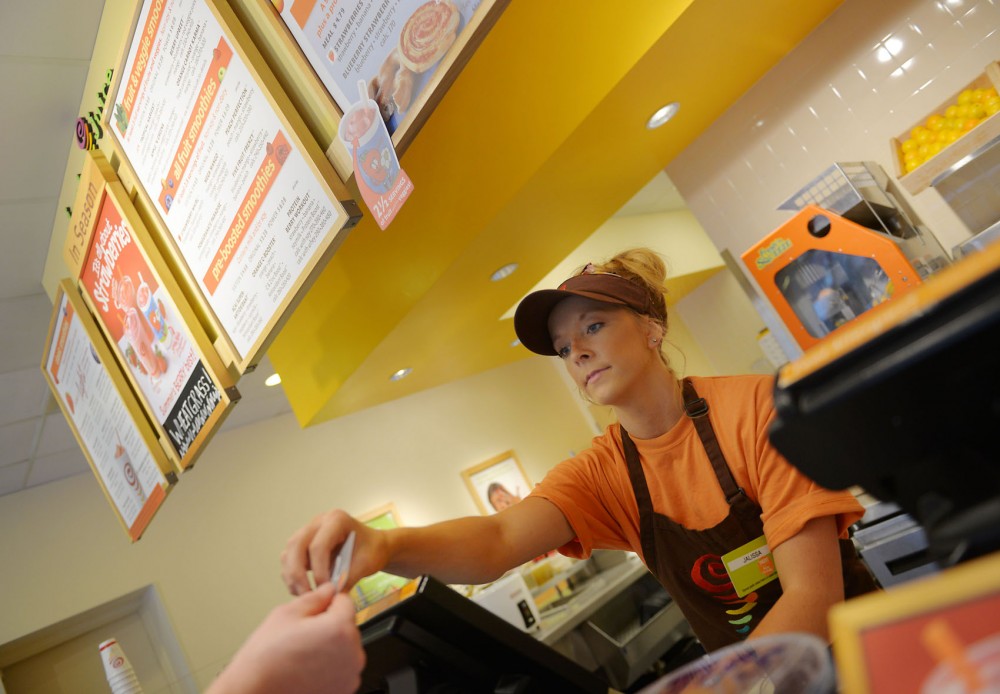When the Affordable Care Act takes effect in 2014, restaurants with more than 20 locations will have to provide more nutritional information to customers.
But listing calorie amounts on chain restaurant menus — one of the new requirements — may not have the power to change people’s eating habits, a recent study found.
The study, published in the American Journal of Public Health in mid-July, suggests consumers ignore calorie information and choose food for taste and convenience, even if the amounts are posted in obvious locations.
On average, about 40 percent of Minnesota college students eat fast food at least once per week and about a third eat at a restaurant at least once per week, according to the University of Minnesota Boynton Health Service’s 2012 College Student Health Survey.
Katie Kasner, a registered dietitian with Boynton, said posting calorie amounts on menu boards is more useful than simply knowing nutrition information is available on a restaurant’s website.
“A good majority of us, when we eat out, we may tend to overeat,” she said. “… It’s a useful tool to be able to see calories listed at the point of purchase.”
University Dining Services started posting calorie amounts on some of its menus in fall 2011, according to a July 25 press release. UDS Director Karen DeVet said their “efforts in the area of nutrition will continue to evolve.”
But it’s unclear whether students take the calorie amounts posted in campus restaurants like Jamba Juice and Papa John’s into account when choosing their meals.
At the Papa John’s location in the St. Paul Student Center, calorie amounts appear on the menu board above the counter. One serving, which is one slice, of cheese or vegetable pizza is listed as 180 calories, but a whole personal pizza has four slices.
Because healthy calorie amounts and serving sizes vary from person to person depending on height, weight and exercise level, understanding individual nutritional needs is important to prevent overeating.
“I may really want to eat this 500-calorie Big Mac,” Kasner said, “but maybe I could just eat less of it.”
Maxine Kobinski, German studies and linguistics junior and Papa John’s employee, said she thinks people might choose a vegetable pizza in an attempt to be healthy, but don’t take the calorie amounts very seriously.
“I don’t think most people even look,” she said. “They already know it’s unhealthy.”
Jamba Juice employee and film studies senior Tessa Lee said some people ask specifically about the nutrition facts of the various smoothies offered, but many end up choosing something regardless of content.
“College kids don’t even care,” she said. “They’ll end up doing whatever because they just want a good smoothie.”
In Dinkytown, Potbelly Sandwich Shop is one of the few restaurants with calorie information posted on their menu board, which started in January.
“I think that people pay attention, but it’s rare,” said Potbelly manager Joel Berlowe .
Occasionally, he said, people will do the math aloud and talk to him about their choices. But more often, customers will look at the menu board and still order something with more calories.
Ted Lins, economics junior, said it’s likely he’ll decide what he wants and then glance at the calorie information.
“If it’s unduly unhealthy,” he said, “I’ll avoid it.”
But Jake Grafenstein, computer science sophomore, said he doesn’t take calorie amounts into
consideration.
“I don’t think counting calories is a good way to manage your diet,” he said. “It has to be a lifestyle change, and having calories listed is not the way to make better choices.”
Kasner said counting calories can be an effective way to lose weight, but it’s not the only one. Choosing to cut back on certain foods, managing portion sizes and cooking at home can have similar effects.
“If you don’t need to lose weight,” she said, “there’s no need to count calories.”
Ana Bohlken, an economics transfer student, said she considers calorie amounts when she eats at restaurants and chooses her foods carefully.
“I’m paranoid about my diet,” she said. “I’ll look for other options if I can.”
While it may seem like some people still choose unhealthy options, Kasner said, more studies need to be done on menu labeling.
“Give it some time,” she said. “Maybe it’ll start to make a difference.”


